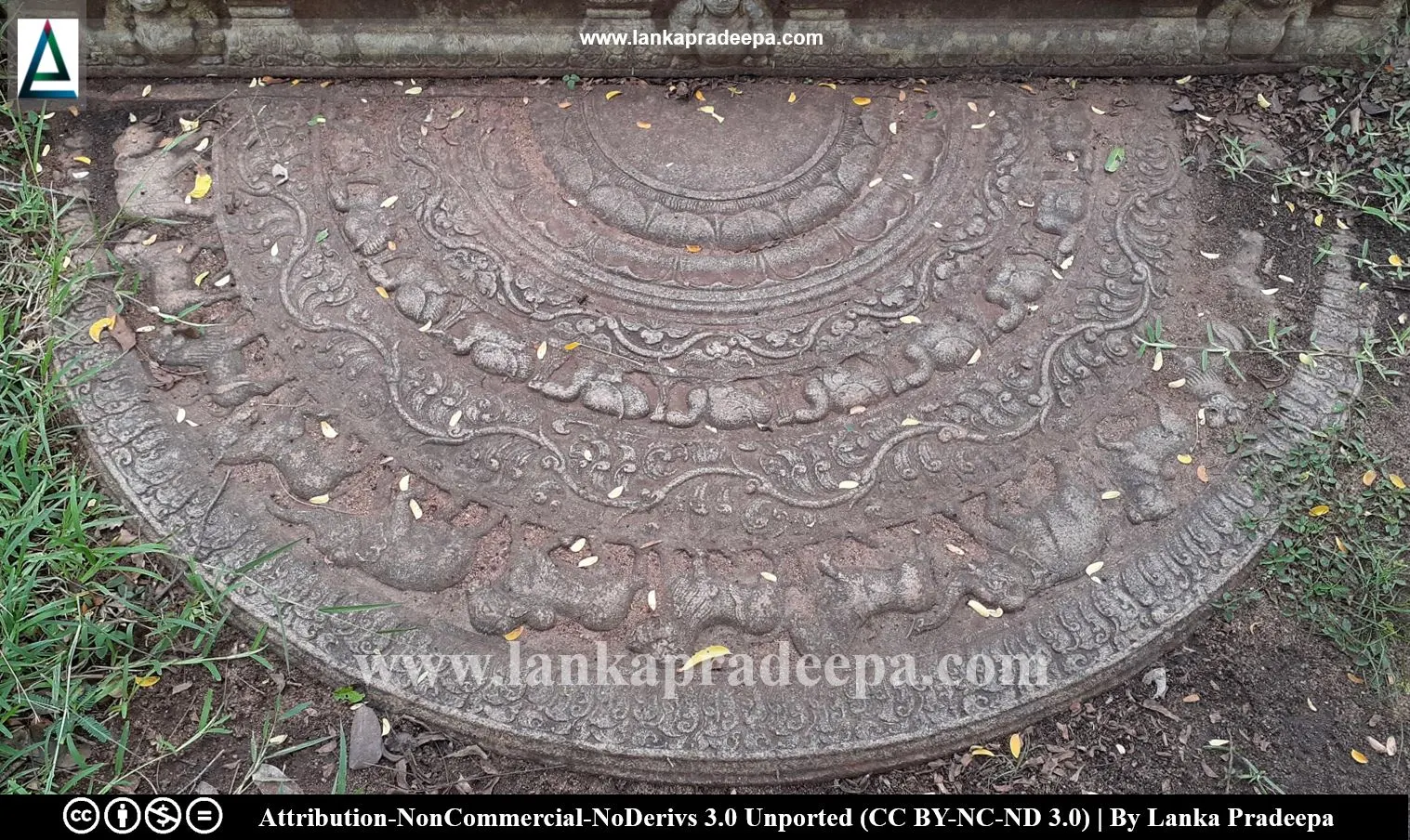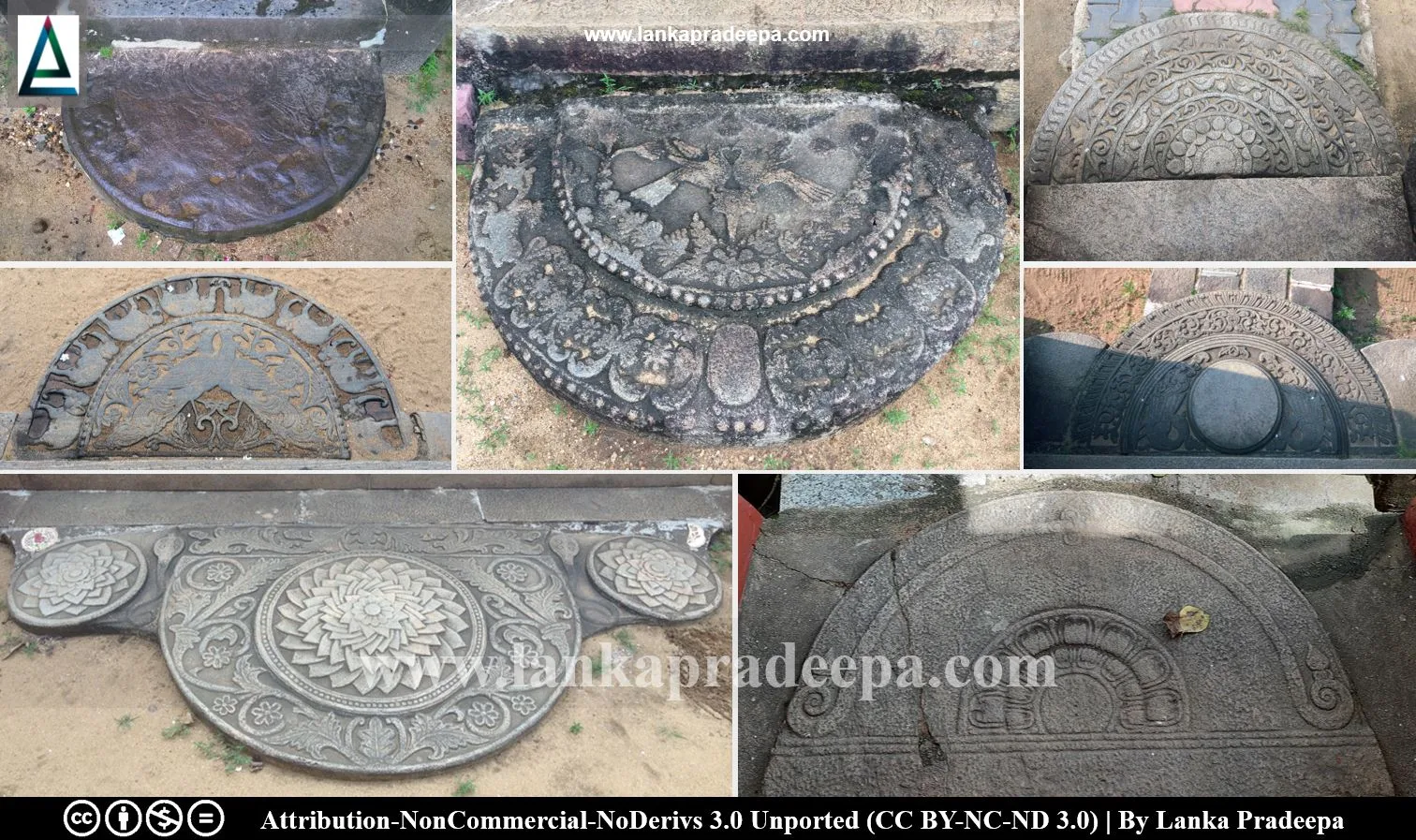
|
Sandakada Pahana |
Sandakada Pahana (Moonstones), or Chandra-pasana, Padi-gala, Padi-puwaruwa is a semi-circular slab (plain or decorated) placed at the foot of the flights of steps leading to Buddhist edifices in Sri Lanka. As per the view of scholars, it acquires a unique and high position among the other elements of the ancient Sinhalese Buddhist architecture in the country. It is also one of an association of three aspects of sculpture that adorned the entrance to buildings in ancient times; the other two being the Muragala (guard stone) and Korawakgala (wingstone).
History
Originated in the Anuradhapura Period, the moonstone continued its function of decorating the entrances to almost all the important temples built during the Kandyan Period (Senadheera, 1990). In the beginning, it was a plain slab of stone and later developed into an artefact of semi-circular shape containing a multitude of carved decorations. Its design has undergone many changes over time and shows a higher level of complexity and creativity towards the end of the Anuradhapura Period.
As is revealed by Samanthapasadika Vinaya Commentary, the term Patika (Pali equivalent of moonstone) was in the use in Sri Lanka in the 5th century A.D. (Vanarathana, 1990). The famous Indian Theravada Buddhist scholar Buddhagosha Thera (5th century A.D.) who interpreted the work Patika in the Mahavagga has said "Patikaya Nibbu Sopanassa Hetta Adda Chanda Pasana Nibbujithva" which means that "Patika" is the moonstone at the foot of the flight of steps (Vanarathana, 1990). The chronicle Mahavamsa also mentions that "Lamkadipamhi samale sabbani ratanani pi Sopanante patikam pi nugghant annesu ku katha?" which means "Nay, but all the jewels in the whole island of Lanka are not of so great worth, as the stone-slab at the foot of the steps" (Devendra, 1965).
Besides Sri Lanka, two examples of moonstones have been recorded in Buddhist ruins in Nagarjunakonada in India where they are found at the entrance to two apsidal temples (Paranavitana, 1954).
Types of Moonstones and Their Cultural Features
The moonstones discovered across Sri Lanka are mainly divided into four types (Vanarathana, 1990);
- The moonstone in the shape of a complete semi-circle with typical cultural features.
- Moonstone with various carvings.
- Simple moonstone without any carvings.
- Elongated moonstone which is not perfectly semi-circular.
Out of these four types of moonstones, the first one is considered the complete type according to the accepted tradition (Vanarathana, 1990). This moonstone contains the cultural features, namely, flames or petal design (on the outer edge), the line of four animals (elephant, horse, lion, and bull), the creeper (with a wavy stem with foliage), the row of geese (Hamsa), the narrow creeper and the half-lotus in the centre (Vanarathana, 1990). Examples of this type of moonstones are found at a number of Buddhist sites in Anuradhapura including Ratnaprasadaya.
Interpretations
Scholars have given many interpretations to the carvings appearing on the moonstones. The first academic who introduced the opinion that they were built to communicate an idea was H.C.P. Bell (Paranavitana, 1954). He with his assistant D.M.de Z. Wickremasingha excavated the Vijayarama Monastery in 1891 and unearthed bronze figurines of animals (elephant, horse, lion, and bull) along with the guardian deities of the quarters (Dik-palas) buried under the floor of each of the four porches at the cardinal points of the edifice (Paranavitana, 1954). Judging from several facts, Bell concluded that these four animals symbolize the quarters: elephant, east; horse, south; lion, north and bull, west (Paranavitana, 1954). He further inferred that the purpose of representing the four animals on moonstones at the entrance to edifices was to indicate that those buildings were open to all Buddhist worshippers of the four quarters (Paranavitana, 1954; Senadheera, 1999).
The opinion of Bell with regard to the significance of the four animals on the moonstone was accepted by V.A. Smith, J.Ph. Vogel and Benjamin Rowland. According to the view of Rowland, the geese (Hamsa) line on the moonstone represents the fifth direction, the sky (Senadheera, 1999). The open lotus that fills the inner half-moon area, as per the belief of William E. Ward, is a symbolical offering of oneself when entering a sacred place (Paranavitana, 1954).
Eminent scholar Senarath Paranavitana also made a wide theory regarding the symbols present on the moonstone (Paranavitana, 1954; Senadheera, 1999). According to him, the outer ring of the moonstone that contains a stripe of flames represents the world in the flames of desire (Jayasuriya, 2016; Paranavitana, 1954; Wikramagamage, 2004). The next stripe containing the figures of four animals symbolizes the four states of life (birth, decay, disease and death) or the circle of existence (Jayasuriya, 2016; Paranavitana, 1954; Wikramagamage, 1990). The thick creeper in the next ring represents the craving or desire (Tanha) and the line of swans in the next inner ring symbolizes purification or differentiating the good and evil (Paranavitana, 1954; Wikramagamage, 2004). After that is another stripe showing a small and less-thick creeper which indicates the diminishing of craving. The half lotus in the inner part of the stone represents Nirvana or the supreme bliss (Wikramagamage, 1990). However, this interpretation by Paranavitana has been rejected by certain other scholars such as D.T. Devendra and G. Senadheera (Devendra, 1965; Senadheera, 1999; Wikramagamage, 1990; Wikramagamage, 2004).
Vinne Vitana who pointed out that the theory of Paranavitana regarding the moonstone is confined to some older specimens gave a new interpretation (Wikramagamage, 1990). He suggested that the moonstone is a composition of symbols associated with the sun and moon worship (Wikramagamage, 1990). Meanwhile, Gunapala Senadheera believed that the moonstone is a complex of symbols arranged to represent an aesthetic meaning (Senadheera, 1999). According to him, the half-circle of the lotus is the world while its petals represent the sun (Senadheera, 1999). The water is denoted by the line of geese and the rumbling creeper in the next stripe is the combination of the earth, sunlight and water (Senadheera, 1999). The four animals in the next line represent some aspects of human life such as strength, speed, growth, physical power, nutrition etc. (Senadheera, 1999).
Moonstones in Each Historical Period
Anuradhapura Period
The early moonstone in the Anuradhapura Period was a plain square one but later its two front sides were carved in order to give it the shape of a half-moon (Vanarathana, 1990). However, it didn't show a perfect semi-circle shape but became nearly so (Vanarathana, 1990). Then at the third stage of its evolution, simple moonstones with a semi-circular shape were created.
Over time, simple carvings started to gradually appear on the moonstones. Before the decorative motifs were added, the moonstones have been established by the use of lines and two examples of that are found in the northeastern section of Abhayagiri Viharaya and the northwestern section of the Mirisaweti Viharaya (Wikramagamage, 1990). Also, a moonstone belonging to its first stage of carvings (which has only half of the lotus) has been discovered from Tissamaharama (Vanarathana, 1990). A moonstone at Abhayagiri Viharaya has a bloomed lotus with a row of geese and a broad festoon indicating an improved state than the one in Tissamaharama (Vanarathana, 1990).
Although it is difficult to ascertain when the four animal figures were added to the moonstone, an example of such a moonstone with the figures of elephant, horse and bull (without lion) has been found on the same Abhayagiri Viharaya premises (Vanarathana, 1990). There are also moonstones made of plain stone splinters (Vanarathana, 1990). Examples of this kind are found at Yatala Vehera, Maligawila, Dighavapi, Rajagala and Somawathi.
By the 9th century, the art of stone carving had reached an acme in its development (Wikramagamage, 1990). The moonstones at Abhayagiri Panchawasa Complex, Dalada Maligawa, and the place near the Basawakkulama at the Maha Viharaya bear sharp and more sophisticated stone carvings indicating flames, the row of four animals, twin creepers, geese and the fully blossomed lotus (Wikramagamage, 1990).
Polonnaruwa Period
The moonstones of the Polonnaruwa Period differ much in decorative content and composition (Basnayake, 1990). Due to the infiltration of ideals of Hinduism and Tantrism, ideological changes occurred in the sphere of religion as well as art (Basnayake, 1990). The slab used for the moonstone became larger than a semi-circle and a decorative band was newly added between the step of the stairway and the moonstone slab (Basnayake, 1990). The line of geese was shifted to an outer band and two animals, the bull and lion, were removed from the traditional four animal squad found in Anuradhapura moonstones (Basnayake, 1990). Instead of decorating a single line with those two animals, the craftsmen of the Polonnaruwa Period tended to decorate a single band with one animal (Basnayake, 1990). Hence there are two different bands with the elephant and horse only (Basnayake, 1990). According to the view of Paranavitana, the omission of the bull from the moonstone may happen due to the Hindu sentiments which held this animal in veneration (Basnayake, 1990). However, the reason for the omission of the lion is unknown but it may be due to the fact that the lion is given a more elevated position in Polonnaruwa buildings (Basnayake, 1990).
The moonstone at the northern entrance to the upper terrace of the Vatadage is considered the best specimen of this kind found in Polonnaruwa (Basnayake, 1990). Also, a special type of moonstone has been found at Alahana Pirivena. It is a square stone containing a lotus symbol in the centre (Vanarathana, 1990). A row of geese is carved on three sides of it running one after the other (Vanarathana, 1990). It is believed that this moonstone has been created during the Anuradhapura Period.
Kandyan Period
The basic half-circle shape of the moonstone gradually approached a circular form or triangular form by the 15th century (Senadheera, 1990). The central semi-circle representing the lotus became a full circle in Kandyan moonstones and in some cases, an additional circular step, much smaller in size, is seen connected with the full lotus by a band of stone (Senadheera, 1990). The two extremes of the base of most of the Kandyan moonstones, whether it be of circular or triangular, are decorated with Tiringitale of Vaka-deka style while the apex of the triangular body is occupied either with a stylized trefoil or with a vase issuing folios and flowers (Senadheera, 1990).
The usual concentric bands in the moonstones of the Anuradhapura and Polonnaruwa periods are not found in the Kandyan counterpart and a high priority has been given to the vegetable motifs (such as vine-scrolls, floral friezes, styled trefoils and torines) while giving less or no attention to the animal motifs (Senadheera, 1990). Two examples of moonstones containing animal figures are found at Dalada Maligawa in Kandy and Horana Raja Maha Viharaya (Senadheera, 1990).

Related Posts
Read Also
References
Books, Journal Articles
1) Basnayake, H.T., 1990. [Wijesekara, N. (Editor in chief)] Section III: 1000-1400 A.D. Archaeological Department Centenary (1890-1990): Commemorative Series: Vol. IV: Sculpture. p.101.
2) Devendra, D.T., 1965. Moonstone Motifs. The Journal of the Ceylon Branch of the Royal Asiatic Society of Great Britain & Ireland, 9(2), pp.221-228.
3) Jayasuriya, E., 2016. A guide to the Cultural Triangle of Sri Lanka. Central Cultural Fund. ISBN: 978-955-613-312-7. p.26.
4) Senadheera, G., 1990. [Wijesekara, N. (Editor in chief)] Section IV: Kandyan Period 1400-1815. Archaeological Department Centenary (1890-1990): Commemorative Series: Vol. IV: Sculpture. pp.142-143.
5) Senadheera, G., 1999. Sandakadapahane sankethavalin adahas vana kaarya pilibanda nava mathayak (In Sinhala). Puravidya, Issue 8. ISSN: 1391-3360. p.70-76
6) Paranavitana, S., 1954. The Significance of Sinhalese'Moonstones'. Artibus Asiae, 17(3/4), pp.197-231.
7) Vanarathana, K. (Mahanayaka Thera), 1990. [Wijesekara, N. (Editor in chief)] Section I: Sculpture and carvings of Sri Lanka from the 1st to 5th century A.D. Archaeological Department Centenary (1890-1990): Commemorative Series: Vol. IV: Sculpture. pp.18-20.
8) Wikramagamage, C., 1990. [Wijesekara, N. (Editor in chief)] Section II: 500-100 A.D. Archaeological Department Centenary (1890-1990): Commemorative Series: Vol. IV: Sculpture. pp.74-76.
9) Wikramagamage, C., 2004. Heritage of Rajarata: Major natural, cultural, and historic sites. Colombo. Central Bank of Sri Lanka. pp.104-105.






